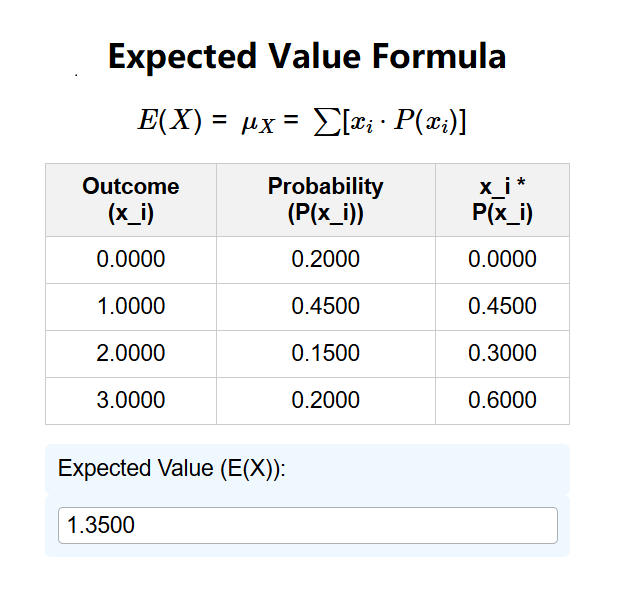1. What is an Expected Value Calculator?
Definition: This calculator computes the expected value (or mean) of a discrete random variable based on its possible outcomes and their associated probabilities.
Purpose: Helps statisticians, researchers, and decision-makers predict the average outcome of a random event over many trials.
2. How Does the Calculator Work?
The calculator follows these steps:
Step 1: Collect Outcomes and Probabilities
\( x_i \text{ and } P(x_i) \)
Where:
- \( x_i \): Possible outcomes of the random variable
- \( P(x_i) \): Probability of each outcome, where \( \sum P(x_i) = 1 \)
Step 2: Calculate Expected Value
\( E(X) = \mu_X = \sum [ x_i \cdot P(x_i) ] \)
Where:
- \( E(X) \): Expected value (mean) of the random variable
- \( x_i \): Each outcome
- \( P(x_i) \): Probability of each outcome
Steps:
- Enter outcomes and their corresponding probabilities.
- Ensure probabilities sum to 1 and are between 0 and 1.
- Calculate the expected value by summing the products of outcomes and probabilities.
- Display results with 4 decimal places.
3. Importance of Expected Value
Calculating expected value is crucial for:
- Decision Making: Evaluates potential outcomes in finance, gambling, and business.
- Statistical Analysis: Provides the long-term average of a random variable.
- Risk Assessment: Helps balance risk and reward in investments.
4. Using the Calculator
Example 1: Outcomes = 4, 8, 6, 3; Probabilities = 0.1, 0.5, 0.04, 0.36
- Verify probabilities: \( 0.1 + 0.5 + 0.04 + 0.36 = 1 \)
- Calculate: \( E(X) = (4 \cdot 0.1) + (8 \cdot 0.5) + (6 \cdot 0.04) + (3 \cdot 0.36) \)
- \( E(X) = 0.4 + 4 + 0.24 + 1.08 = 5.72 \)
- Result: Expected Value = 5.7200
Example 2: Dice roll with outcomes 1 to 6, each with probability \( \frac{1}{6} \)
- Calculate: \( E(X) = (1 \cdot \frac{1}{6}) + (2 \cdot \frac{1}{6}) + (3 \cdot \frac{1}{6}) + (4 \cdot \frac{1}{6}) + (5 \cdot \frac{1}{6}) + (6 \cdot \frac{1}{6}) \)
- \( E(X) = \frac{1 + 2 + 3 + 4 + 5 + 6}{6} = 3.5 \)
- Result: Expected Value = 3.5000
5. Frequently Asked Questions (FAQ)
Q: What if probabilities don’t sum to 1?
A: The calculator will display an error message prompting you to adjust the probabilities.
Q: Can probabilities be negative?
A: No, probabilities must be between 0 and 1, or an error will be shown.
Q: Is expected value always an achievable outcome?
A: No, it’s a theoretical average. For example, a dice roll’s expected value is 3.5, which isn’t a possible outcome.
Expected Value Calculator© - All Rights Reserved 2025
 Home
Home
 Back
Back
